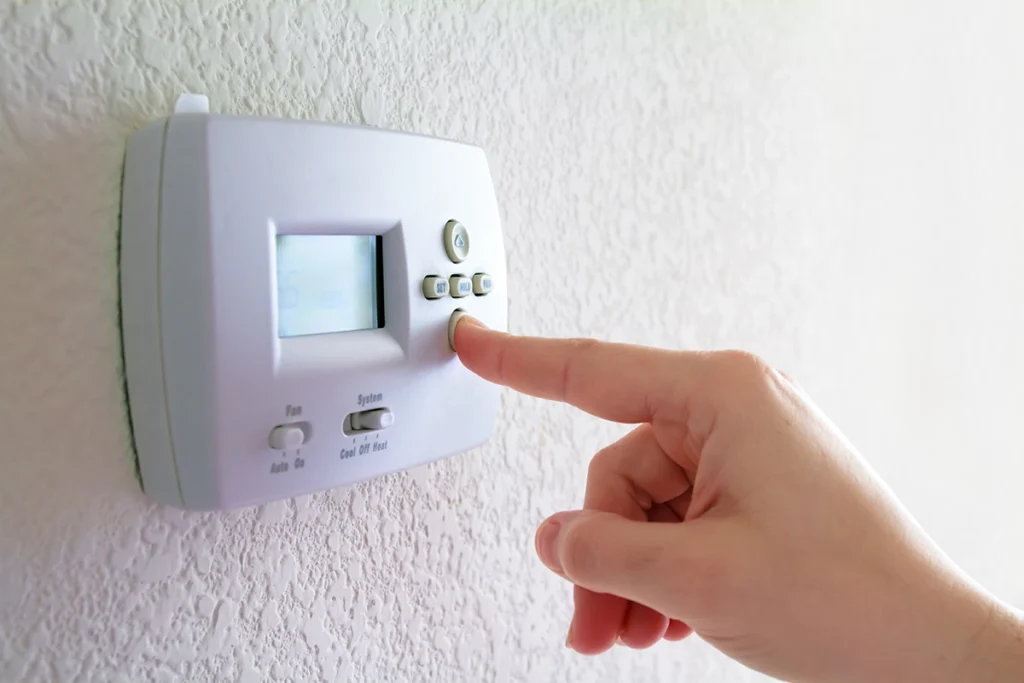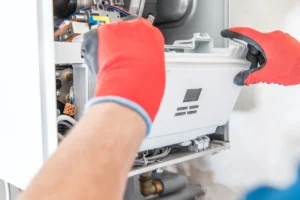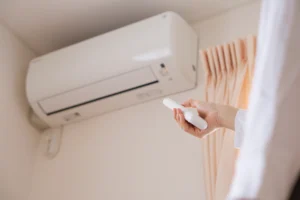When the weather drops lower than your heat pump can handle, you may notice something new on your thermostat: AUX. We hear this question a lot—what is aux heat, and do I need to worry about it? The good news is that it’s normal. But understanding how it works helps you stay comfortable without driving your energy bills through the roof.
What Is Aux Heat?
Auxiliary heat, usually called aux heat, is your system’s backup. A heat pump does a great job in mild to chilly weather. But when it gets really cold outside, it struggles to pull in enough warmth from the air. That’s when auxiliary heat kicks in.
Most systems use electric resistance coils for this backup. Some pair with gas. Either way, it’s designed to keep your home warm when the heat pump alone can’t.
Now, because auxiliary heat uses more power, it’s not meant to run all the time. Knowing when it’s on—and when it’s not—can save you money.
Since aux heat is unique to heat pumps as a backup system, you might be wondering how they stack up against traditional furnaces. For a full breakdown of which system might suit your needs, check out our guide heat pump vs furnace: which is better.
Why Does Aux Heat Turn On?
Aux heat comes on in a couple of common situations:
Frigid temperatures – When your heat pump can’t hit the thermostat setting by itself.
Defrost cycles – When ice forms on the outdoor unit, the system switches to aux heat briefly while it clears.
Both are totally normal. But if you see “AUX” showing up a lot on mild days, something might be wrong.
During extreme cold snaps, which can arrive earlier than expected in many regions, auxiliary heat often plays a bigger role in keeping homes comfortable.
What Is Aux Heat on a Thermostat?
If your thermostat displays “AUX,” it’s just letting you know the backup heat is active. One of the most common triggers is a big jump in your settings. For example, going from 65° to 75° in a hurry often forces the system to call for auxiliary heat.
That’s why we usually recommend smaller temperature changes. It takes a little patience, but it helps cut down on unnecessary auxiliary heat use.
How Aux Heat Affects Energy Bills
Here’s the part that surprises homeowners: auxiliary heat isn’t cheap to run. According to the U.S. Department of Energy, electric resistance heating is one of the most expensive ways to heat a house.
That doesn’t mean it’s bad—it’s your system’s safety net. But if it runs for hours every day, you’ll notice the difference on your bill.
Clearing Up a Common Mix-Up
People often think aux heat and emergency heat are the same. They’re not.
Aux Heat – Automatic, kicks on when the system needs backup.
Emergency Heat – You turn it on manually when the heat pump isn’t working.
Unless your heat pump has failed, you don’t need to flip the emergency switch.
What Is Aux Heat in Everyday Use?
Day to day, auxiliary heat is nothing to stress over. In milder climates, you might hardly ever see it. In colder regions, you’ll see it more during the heart of winter.
Still, if “AUX” shows up every day when it’s only cool outside, it’s worth getting checked out. Dirty filters, refrigerant problems, or a faulty sensor could all be to blame.
When It’s Time to Call for Service
Reach out to a pro if you notice:
Aux heat running even above freezing
A sudden spike in energy bills
Rooms not reaching the set temperature
Strange noises from the outdoor unit
Catching these issues early usually saves money in the long run. And if your system is older or struggling year after year, our team can help with expert heat pump installation and replacement to keep your home comfortable and efficient.
Cutting Back on Aux Heat Use
Want to keep auxiliary heat from running more than it needs to? Here are a few simple tips:
Replace or clean filters regularly
Don’t raise the thermostat too quickly
Seal up leaks around windows and doors
Schedule seasonal HVAC maintenance
Check that your home has good insulation
Each step makes a difference—and together, they really add up. If you’re curious about old-school ways people have predicted tough winters, the Farmers’ Almanac shares 20 signs of a cold and harsh winter.
Why Professional Care Helps
Aux heat is there to protect you, but it should only be a backup. We get calls every winter from homeowners worried about seeing “AUX” on their screens. Sometimes it’s just the system doing its job. Other times, it’s a sign that something needs attention.
Routine maintenance keeps your heat pump running efficiently and makes sure auxiliary heat only shows up when it truly has to. That way, you stay comfortable without overspending on energy.
Final Thoughts: What Is Aux Heat?
So, what is aux heat? It’s the backup plan your heat pump uses when the weather gets too cold or when the system needs a little help. It does use more energy, but it’s an important safeguard for keeping your home warm.
If you’re worried about how often it’s running, Sub Zero Temp Control is here to help. We serve Vancouver, WA, and beyond, making sure homeowners understand their systems and stay comfortable no matter what the weather brings.
Have questions or need service? Contact us today to schedule an appointment and keep your system running the way it should.






